Calculating Copies per Microliter (copies/μL) from qPCR without Amplicon Size

You can calculate copies per microliter from qPCR data without knowing the amplicon length by using appropriate standards and considering the type of template and input volumes. The amplicon size is important only if the standard depends on molecular weight calculations involving base pair length, such as plasmid or amplicon standards. When using genomic DNA or standard curves from known genome equivalents, you can bypass the need for base pair length entirely.
Understanding the Role of Amplicon Size in Copies/μL Calculations
Amplicon size impacts how you convert DNA mass to copy numbers. The molecular weight of a nucleic acid is proportional to its base pair length. This weight defines how many molecules exist per unit mass.
- If your standard is a plasmid or a purified amplicon, you must know the exact size of the plasmid or amplicon (base pairs) to calculate the weight of a single molecule.
- Knowing that weight allows you to convert mass concentration (e.g., pg/μL) from the qPCR standard into copies/μL.
Without the amplicon or plasmid length, precise conversion from mass to molecules is not feasible in these scenarios.
Calculating Copies/μL with a Standard Curve and Template Type
Most qPCR experiments generate a standard curve using known DNA concentrations. This standard curve relates cycle threshold (Ct) values to the amount of template DNA in the reaction. To extract copies/μL from the curve, the template details matter.
| Template Type | Requirement | Calculation Principle |
|---|---|---|
| Plasmid DNA or Amplicon | Molecular weight via size (bp) | Copies/μL = (Plasmid concentration [pg/μL]) ÷ (Weight per molecule [pg]) |
| Genomic DNA (e.g., human) | Known genome mass per haploid copy | Copies/μL = (DNA concentration [pg/μL]) ÷ (Mass per genome copy [pg]) |
The critical step is knowing the weight per molecule.
Why Plasmid Weight Calculation Requires Amplicon Size
A plasmid standard contains the vector backbone plus the inserted amplicon sequence. To calculate weight per plasmid molecule, you must add the size of the insert and the vector. The molecular weight (in base pairs) times the average weight of a base pair (approximately 650 Daltons) gives the plasmid mass per molecule. This figure is used to convert plasmid concentration to copy number. Without knowing size, this is infeasible.
How to Calculate Copies/μL Using Genomic DNA Without Amplicon Size

If purified genomic DNA is the standard, amplicon size is irrelevant because the genome mass per copy is known. For instance, in humans:
- One haploid genome weighs about 3.2 picograms (pg).
- Thus, 1 copy of a target equals 3.2 pg DNA.
- If the DNA standard concentration is, say, 5 ng/μL (5000 pg/μL), you calculate copies/μL as:
Copies/μL = (5000 pg/μL) ÷ (3.2 pg per haploid copy) ≈ 1562 copies/μL
This method works for any genome where the DNA mass per haploid genome copy is known. Users avoid the need for amplicon size or plasmid calculations. It is suitable when the target is a single-copy gene within the genome.
Adjusting for Template Volume Added to qPCR Reaction
qPCR quantifies the absolute number of target copies per reaction, which depends on the volume of template added. This is crucial because:
- If you add varying template volumes in different wells, the absolute copy number per reaction changes.
- Using concentration in copies/μL assumes a consistent template input volume across all reactions (standards and unknowns).
- If volumes differ, you must multiply copies/μL by the volume added to reflect the true copy number in each reaction.
Accurate copy number calculation must factor in the volume of template added to the reaction, or else results lose comparability.
When Amplicon Length Does Not Matter
Amplicon length relevance is limited to certain standard types. Specifically:
- If you use the purified amplicon itself as a standard, its size is essential to calculate weight per molecule.
- If standards are plasmids containing the amplicon, size (vector + insert) affects molecular weight calculations.
- Using genomic DNA standards from diploid or haploid genomes removes the need for amplicon length, as the genome weight per copy serves as the standard.
Matching the standard type to your available data helps decide whether amplicon length is necessary.
Step-by-Step Guide to Calculate Copies/μL without Amplicon Size
1. Identify Template Type Used for Quantification
- Is your standard plasmid DNA, synthesized amplicon, or genomic DNA?
- Only genomic DNA or known genome equivalents enable size-free calculation.
2. Obtain the Concentration of Your Standard
Measure DNA concentration using fluorometric or spectrophotometric methods (e.g., Qubit, Nanodrop). Units should be in ng/μL or pg/μL.
3. Use Known Genome Mass per Copy for Genomic Standards
- Example: Human haploid genome mass = 3.2 pg per copy.
- Calculate copies/μL = (DNA concentration [pg/μL]) ÷ 3.2 pg.
This yields the number of haploid genome copies per microliter in your standard.
4. Confirm Template Input Volume per Reaction
Ensure consistent template volume in qPCR wells. If variable, multiply copies/μL by the volume added to get total copies per reaction.
5. Apply Standard Curve to Unknowns
Use Ct values of standard samples to generate the curve. Then interpolate copy numbers for unknown samples using the curve. Convert per reaction copy numbers as needed.
6. Consider Alternative Approaches if Using Plasmids Without Size Info
- Estimate plasmid size based on vector backbone size from vector maps plus approximate insert length if known.
- Sequence the plasmid or perform gel electrophoresis with size markers to estimate length.
- Otherwise, use genomic DNA standards to avoid dependency on amplicon size.
Examples Illustrating Calculation Without Amplicon Size
Example 1: Human Genomic DNA Standard
A genomic standard has concentration 10 ng/μL. For human haploid genome mass 3.2 pg:
Copies/μL = (10,000 pg/μL) ÷ (3.2 pg) = 3125 copies/μL
No amplicon length needed.
Example 2: Variable Template Volumes
You added 5 μL of a standard containing 3125 copies/μL to reaction wells:
Copies per reaction = 3125 copies/μL × 5 μL = 15,625 copies added
Shows importance of input volume consideration.
Summary of Key Points
- Amplicon size is necessary only when calculating molecular weight of plasmid or amplicon standards.
- Using genomic DNA standards with known genome mass per copy bypasses need for amplicon length.
- Copies/μL is calculated by dividing DNA concentration (pg/μL) by mass per genome copy (pg) for genomic standards.
- Be sure template volumes are constant; adjust copy numbers if volumes vary between reactions.
- Without plasmid or amplicon size, use estimated genome equivalents or sequence-based size estimations for plasmids.
How can I calculate copies per microliter from qPCR without knowing the amplicon size?
If you use whole genomic DNA as a standard, you can bypass amplicon size. For example, human DNA has 3.2 pg per haploid genome. Divide DNA concentration (pg/μL) by this value to estimate copies/μL.
Why is knowing the amplicon size often necessary for copies/μL calculation?
Amplicon size lets you calculate plasmid weight accurately. Without it, you cannot determine molecular weight of your plasmid or amplicon, making it impossible to convert concentration to copy number precisely.
Can I calculate copies/μL using a standard curve if I don’t have plasmid size?
Yes, but only if your standard is genomic DNA or another molecule with a known fixed weight per copy. For plasmid standards, you need the total base pair length to find molecular weight and calculate copies correctly.
How does the volume of template added affect copy number calculation?
Copy number depends on the amount of template added to each reaction. Using different template volumes requires adjusting calculations, since qPCR measures total copies in the reaction, not concentration alone.
When is amplicon length irrelevant in copies/μL calculations?
Amplicon length is irrelevant if you use genomic DNA standards with known genome weight. It only matters when your standard is the amplicon or plasmid containing that amplicon, which directly affects molecular weight calculations.





Leave a Comment